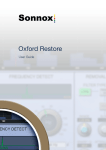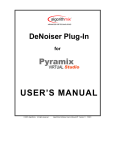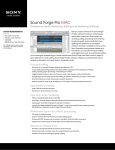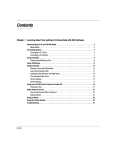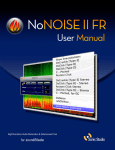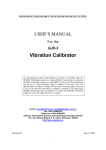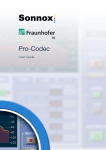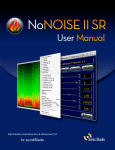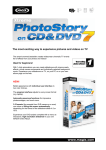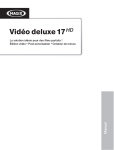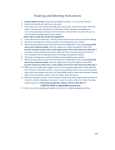Download Sonnox Restore QuickStartGuide-1-2
Transcript
Contents 1 Introduction 1.1 Restoration Processing Workflow . . . . . . . . . . . . . . . . . . . . . . . . . 2 The Oxford DeClicker 3 3 4 2.1 Description of Controls . . . . . . . . . . . . . . . . . . . . . . . . . . . . . . 4 2.2 Quick Start Guide . . . . . . . . . . . . . . . . . . . . . . . . . . . . . . . . . 5 2.2.1 Dialogue Mode . . . . . . . . . . . . . . . . . . . . . . . . . . . . . . . 5 2.2.2 Setting up the Side-Chain . . . . . . . . . . . . . . . . . . . . . . . . . 5 3 The Oxford DeBuzzer 7 3.1 Description of Controls . . . . . . . . . . . . . . . . . . . . . . . . . . . . . . 7 3.1.1 Frequency Detect Panel . . . . . . . . . . . . . . . . . . . . . . . . . . 7 3.1.2 Removal Panel . . . . . . . . . . . . . . . . . . . . . . . . . . . . . . . 9 3.2 Quick Start Guide . . . . . . . . . . . . . . . . . . . . . . . . . . . . . . . . . 10 4 The Oxford DeNoiser 11 4.1 Description of Controls . . . . . . . . . . . . . . . . . . . . . . . . . . . . . . 11 4.1.1 Graph Area . . . . . . . . . . . . . . . . . . . . . . . . . . . . . . . . . 12 4.1.2 De-Hisser Panel . . . . . . . . . . . . . . . . . . . . . . . . . . . . . . 13 4.1.3 Detect Panel . . . . . . . . . . . . . . . . . . . . . . . . . . . . . . . . 13 4.1.4 Removal Panel . . . . . . . . . . . . . . . . . . . . . . . . . . . . . . . 14 4.2 Quick Start Guide . . . . . . . . . . . . . . . . . . . . . . . . . . . . . . . . . 15 4.2.1 Simple Broad-band Noise Removal . . . . . . . . . . . . . . . . . . . 15 4.2.2 Complex Noise Removal . . . . . . . . . . . . . . . . . . . . . . . . . 15 5 Preset Manager Toolbar 17 6 Supported Platforms 18 7 System Requirements 18 8 Copyright and Acknowledgements 19 1 1 INTRODUCTION Introduction The Sonnox Restore suite is a collection of three plug-ins designed to clean the sound of digital audio recordings that are damaged by • pops, clicks, or crackle • hum, buzzes and whines • noise The tools are not just for restoring old material, but also for removing the clicks, pops, buzzes and background noises that can sometimes accidentally occur in new recordings. A great deal of time has been put into making the Sonnox Restore suite as intuitive as possible in terms of providing excellent visual and graphical feedback. They also include some innovative solutions not seen before in the restoration field, the intention being to enable quick and accurate repair of a variety of spoiled recordings. This quick-start guide contains a description of the most important controls and some initial guidelines to help the first-time user set up and use the plug-ins for the first time. The user manual documents the plug-ins in full and should be consulted to get the best out of the plug-ins. 1.1 Restoration Processing Workflow It is usual practice to use the DeClick process first, particularly if there are large disturbances present that require repair. The optimal order for DeNoise and DeBuzz is probably dependent on the programme material. If a loud buzz is dominating low-level noise it would be sensible to remove the buzz first; on the other hand the presence of significant noise might make it more difficult for the DeBuzz detector to lock on to a low level buzz component. www.sonnox.com 3 Go to contents 2 2 2.1 THE OXFORD DECLICKER The Oxford DeClicker Description of Controls THRESHOLD This control is used to adjust a threshold level within the excitation profile to capture an event. If a peak on the excitation profile is below the threshold, it will not be registered as an event to be repaired. If a peak breaches the threshold line, then it is registered as a detected event and can be repaired. SENSITIVITY “Sensitivity” – This control determines whether detected events are discarded, starting with the smallest. A low sensitivity means only the largest of the detected events go forwards to the repair section. ENABLE With the section disabled, the detectors are still monitoring the audio and any detected events are shown on the Events Graph as red bubbles. Setting the section IN will present the detected events to the repair processing. www.sonnox.com 4 Go to contents 2.2 Quick Start Guide 2.2 2 THE OXFORD DECLICKER Quick Start Guide 1. Lower the DePop Threshold until it is sitting just above the floor of the Excitation Profile. 2. Lower the Sensitivity until only the Pops you want to remove are being removed, and nothing more. 3. Repeat 1 and 2 for DeClick section. 4. Repeat 1 and 2 for DeCrackle section. 5. Review the material all the way through to check if the settings are good for all the material. If not, consider snap shot automation of different passages, or for dialogue consider using the Dialogue Mode. 6. Remember that a useful tip is to automate the Exclude Box Enable button. 2.2.1 Dialogue Mode 1. Click on Dialogue Mode button. 2. Adjust the Voice Threshold slider to make the threshold be just above the background level while the speaker pauses. 3. Click on the “Below Set” button, and adjust the Threshold/Sensitivity controls of all three sections to make repairs to the background. 4. Click on the “Above Set” button, and adjust the Threshold/Sensitivity controls of all three sections to make repairs to the speech. 5. Listen to the material to evaluate the repair work all the way through. If not, consider using the side-chain to make the Above/Below decision be based on a particular band of the frequency spectrum rather than the overall level. 2.2.2 Setting up the Side-Chain To set up the Side Chain, first click on the Side Chain button in the listen section of the output panel, so you hear the output of the Side Chain. Then adjust the LF filter and HF filter to isolate the band you want to use to feed the Voice Threshold control. What you are hearing is what is fed to the Voice Threshold, which determines whether the input signal is Above or Below the threshold. Then go back to listening to the audio output. www.sonnox.com 5 Go to contents 2.2 Quick Start Guide 2 THE OXFORD DECLICKER You will notice that when you touch the LF or HF controls, the graph shows you an FFT plot of the signal. You can drag the end stops in (which are the LF and HF controls), and drag the threshold level (which is the Voice Threshold) to set it all up according to what you are seeing. www.sonnox.com 6 Go to contents 3 3 THE OXFORD DEBUZZER The Oxford DeBuzzer 3.1 Description of Controls 3.1.1 Frequency Detect Panel AUTO Auto mode is the default tracking mode. In this mode the removal filters automatically follow the peak frequency found in the peak profile. It is suitable for tracking a weak, slowly wandering fundamental and operates over all three frequency bands. FAST Fast tracking mode allows the removal filters to automatically follow a quickly wandering fundamental. This mode operates on MF and HF frequency selections only. FREEZE For a fundamental that is a fixed frequency, once the auto mode has found the best nominal frequency, you can freeze the nominal. In freeze mode, the removal filters www.sonnox.com 7 Go to contents 3.1 Description of Controls 3 THE OXFORD DEBUZZER follow the value of the nominal frequency set by the big rotary frequency control. SENSITIVITY Start at a high value and back off to the point at which the hum becomes audible again, then push it up a little to make the hum disappear. Doing this correctly ensures least damage to the signal. ALT Mode This allows two different modes for hum removal. Try both modes with the sensitivity knob, and use the mode that allows the lowest setting of the sensitivity. TONE ON Enables the onboard tone generator which can be useful for finding the frequency of unusual hums, whines or whistles. TONE LEVEL Allows you to set the level of the tone generator. FINE ADJUST Sets the Frequency control to have a much finer range so that it is easy to home into a precise frequency value. Holding down shift while moving the Frequency knob enables an extreme fine adjust, where the frequency can be accurately determined to 0.0001 Hz. If Fine Adjust is selected while in Auto tracking mode, the detector is forced into Freeze mode and the Freeze mode button flashes. Exiting Fine Adjust returns to Auto mode. FREQUENCY RANGE Buttons These three buttons set which frequency band the big rotary control will operate over. LF = 20Hz to 160Hz. MF = 160Hz to 1280Hz. HF = 1280Hz to 20kHz. The peak profile is not active for the HF range. Hz The Frequency control in the centre is used to set the nominal frequency about which in Auto mode the detection algorithms hunt for a peak in the peak profile. In Freeze mode it determines the frequency of the removal filters. The frequency can be selected using the scribble tab in units of 1Hz (normal), 0.01Hz (Fine adjust) and 0.0001Hz (extreme fine adjust). www.sonnox.com 8 Go to contents 3.1 Description of Controls 3.1.2 3 THE OXFORD DEBUZZER Removal Panel COMB Sets the removal filters to be a comb filter. Comb is best for Auto mode, and for when there are many harmonics in a buzz. PARAM EQ Sets the removal filters to be a narrow notching parametric EQ. You may prefer the sound of these filters when there are few harmonics. Also, it is probably best to select Param EQ to remove an HF whine; if the user selects the HF frequency band while in Comb mode a small red indicator flashes on this button as a reminder. +EVEN When using the Param EQ option, by default even harmonics are not notched out because frequently they are not present. Enabling this control will notch out even harmonics. RANGE This sets the frequency above which there are no notches. This needs to be as low as possible to avoid loss of MF and HF information, but high enough to take out all the harmonics of a buzz. Range cannot be set lower than 10% above the fundamental. SHARP/Q Adjusts the width or sharpness of the notches. When too sharp, the filters tend to ring. When too wide, the filters take out too much of the audio around the harmonics. So adjusting this is a matter of finding a suitable compromise. ATTENUATION Set this to the minimum attenuation that will make the hum or buzz inaudible. www.sonnox.com 9 Go to contents 3.2 3.2 Quick Start Guide 3 THE OXFORD DEBUZZER Quick Start Guide 1. Find the nominal frequency. Start with the Sensitivity at maximum, Range and Attenuation controls at medium settings, and Sharp/Q relatively wide. Alt Mode off. If it is a low frequency buzz you are looking to remove, then play the music through the plug-in for a while and look at the FFT plot. It will give you an idea of any persistent low frequencies. Then set the big central rotary control to that frequency, or click on the peak in the FFT plot to do the same thing. If that is the right frequency, you will hear the hum disappear. If not, look at the peak profile to see what is happening. If there is no discernable peak then you may be an octave too high, so try going to half that frequency. If it is a higher frequency, set to Freeze mode, just look for it in the FFT plot, and click on the peak that is found. 2. Once the hum has disappeared, you then need to refine the removal process to make it remove only the minimum necessary. To do this, click on Diff so you can hear what is being removed. 3. Next, adjust the Range (either using the control, or by dragging the green drag handle on the graph) to bring it down to being just above the highest harmonic you want to remove. 4. Next, adjust the Sharp/Q control to be the best compromise between being too wide (too much audio is heard with the hum) or too narrow (the filters ring too much). 5. Next, switch back to listening to Audio mode, and reduce the Attenuation control clockwise so that the hum is just inaudible. 6. Next, adjust the Sensitivity control to be as low as possible (to cause least damage); simply reduce the sensitivity from 100 until the hum or buzz becomes just audible, then increase slightly until it disappears. Repeat this with Alt mode on. Use the Mode which allows the Sensitivity to be least. 7. Decide if you want to try using the parametric EQ to remove the hum. If so, you may need to re-adjust the Sharp/Q, and set the Slope. www.sonnox.com 10 Go to contents 4 4 4.1 THE OXFORD DENOISER The Oxford DeNoiser Description of Controls www.sonnox.com 11 Go to contents 4.1 Description of Controls 4.1.1 4 THE OXFORD DENOISER Graph Area Select the audio channel to view in the FFT display Toggle the law of the frequency axis. Lin shows greater HF precision, Log shows greater LF precision Select which Bias Curve is visible Reset all nodes of the visible Bias Curve Threshold Bias is red, and the red trace shows the biased Threshold Level Reduction Bias is yellow, and the yellow trace shows the biased Threshold Level The grey trace shows the un-biased Threshold (for reference) Click+Drag a node to adjust the bias at that frequency. Shift+Click+Drag to adjust a node and all nodes below it. Double-Click to reset a node, or Shift+Double-Click to reset a node and all nodes below it. www.sonnox.com 12 Go to contents 4.1 Description of Controls 4.1.2 4 THE OXFORD DENOISER De-Hisser Panel Select the frequency above which the De-Hisser is active Adjust the reduction amount in dBs Enable and Disable the De-Hisser processing 4.1.3 Detect Panel In some situations this can help to remove musical noise. Adjust the ‘peakiness’ of the noise profile. AUTO — Enables automatic updating of noise profile and the noise profile level relative to the input signal. This is the most critical control to get right. It sets the level of the threshold about which noise reduction takes place. FREEZE — Once you have obtained a good profile, this button will freeze the profile to prevent it updating. Frequency components below the threshold are attenuated, whereas components above the threshold are left alone. MANUAL — In this mode, the profile is forced flat. You can then use the Colour, Air or bias controls to modify the shape of the profile. Modify the LF shape of the noise profile. www.sonnox.com Modify the HF shape of the noise profile. 13 Go to contents 4.1 Description of Controls 4.1.4 4 THE OXFORD DENOISER Removal Panel This is a simple low pass filter with a fixed -18dB attenuation. It is active when the DeNoiser Enable and Master Enable are both active. Provides a way to adjust the level of the de-noised signal to compensate for any loss in level due to the denoising process. This makes it easier to perform with and without de- noising comparisons using the master IN button. Set the amount of attenuation of broadband noise components below the threshold. For stereo inputs, this applies noise reduction to the Side channel. The Mid channel is unaffected. If Master Enable is also IN, this makes the broadband DeNoiser active using glitchless switching. www.sonnox.com 14 Go to contents 4.2 Quick Start Guide 4.2 4 THE OXFORD DENOISER Quick Start Guide 1. Click on the ENABLE button of the DeHisser. 2. Set Cutoff to the desired frequency between 3kHz and 15kHz. 3. Set the Reduction to 0dB. Lower slowly to the point where hiss reduction is acceptable. 4.2.1 Simple Broad-band Noise Removal 1. Leave in Auto mode. For simple broad-band noise reduction, set the Reduction slider of the Removal section to around -12dB. 2. Adjust the Threshold slider to find the right balance between being too low (not enough noise is removed) and too high (too much audio is also removed). You may find it easier to listen to Diff mode, where you are listening to what has been removed. The idea is to have the maximum amount of noise and hiss in this signal, with the minimum amount of original signal. 3. See if adjusting the Smooth control gives a more pleasing result. 4. If necessary, adjust the Tune control to reduce “twinklies” (musical noise). 5. Set the Reduction to 0dB, and then very slowly lower the control until the amount of noise reduction is acceptable. 6. You can use the Makeup control in the removal section to do some critical comparison.. After noise reduction, the level of the signal may be significantly lower. If this is so, you can use the Makeup control to add gain to make it closer to the original. Then you can use the master ENABLE button to do glitch-less comparison of with and without noise-reduction, comparing like-level with like-level. 7. Once you are happy that you have a sympathetic treatment of the noise, you can then consider adding some warmth back to the output using the Warmth control. 4.2.2 Complex Noise Removal The DeNoiser provides significant ability to vary the shape of the noise threshold profile and the noise removal. For best results, here are some additional suggestions. 1. For surgical noise removal, set the Reduction slider of the Removal section to 0dB and activate the yellow reduction bias curve using Bias Reduction button. This www.sonnox.com 15 Go to contents 4.2 Quick Start Guide 4 THE OXFORD DENOISER allows the noise reduction to be modified in smaller frequency bands. Listen to the audio signal, and bring down the grab handles on the yellow curve. Listen to the removal of noise in that band, and carefully balance against the preservation of the audio signal. 2. Now listen to the critical frequencies of the material to evaluate whether you could adjust the red threshold bias curve to be more sympathetic to these parts. This would mean slightly lowering the threshold bias handles in the critical regions of the frequency spectrum to reduce noise reduction there and preserve more of the original audio, and perhaps to lift the bias controls in the HF area to remove more hiss. 3. If you have a constant noise floor, try to find a segment with no signal and use Freeze mode. All the threshold profile and noise reduction biasing controls will help you modify the curves. 4. Surprisingly good results can be obtained quickly using a manually-shaped fixed curve. Select Manual mode. Use the Colour control to modify the noise profile at LF, perhaps by mimicking a pink noise curve. Use the Air control to modify the noise profile at HF, which can help preserve HF signal frequencies. The noise profile can be further shaped in smaller frequency bands by using the bias curve handles. www.sonnox.com 16 Go to contents 5 5 PRESET MANAGER TOOLBAR Preset Manager Toolbar Sonnox Oxford plug-ins come equipped with their own onboard Preset Manager, which is displayed at the top of the plug-in window. The reasoning behind this is to allow increased portability of your presets across all the host applications, while also providing a consistent and versatile interface. While most host platforms allow creation and loading of presets, those host-created preset files are not portable between different host applications. With the Oxford plug-ins’ Preset Manager, you can create a named preset in one host application and load it when using an alternative application. The Sonnox Preset Manager is fully described in a companion document — Sonnox Toolbar and Preset Manager User Guide — available for download at www.sonnox.com/docs www.sonnox.com 17 Go to contents 7 6 SYSTEM REQUIREMENTS Supported Platforms • Avid Pro Tools (AAX Native 32/64-bit) • VST hosts (32/64-bit) • AU hosts (32/64-bit) • Mac Intel OSX 10.6 or higher • Windows 7 and 8 (32/64-bit) 7 System Requirements For latest System requirements, please visit www.sonnox.com. All versions • Free iLok account • Appropriate product licence • iLok2 Pro Tools • Approved Digidesign/Avid CPU and hardware configuration • Pro Tools 10.3.5 (Native or HD), or higher VST Native • VST compliant host application (e.g. Cubase, Nuendo, etc.) Audio Units • Approved Apple CPU and OSX 10.6 or higher • Audio Unit Host application (e.g. Logic, Digital Performer, etc.) www.sonnox.com 18 Go to contents 8 8 COPYRIGHT AND ACKNOWLEDGEMENTS Copyright and Acknowledgements Trademarks and content copyright © 2007-present Sonnox® Ltd. All rights reserved. Sonnox® and the five dots logo are registered trademarks of Sonnox Ltd. This product is manufactured and supplied by Sonnox Ltd. This product is protected by one or more European and/or US patents. DIGIDESIGN, AVID and PRO TOOLS are trademarks or registered trademarks of Avid Technology Inc. VST is a trademark of Steinberg AG. All other product and Company names are trademarks or registered trademarks of their respective holders. www.sonnox.com 19 Go to contents



















